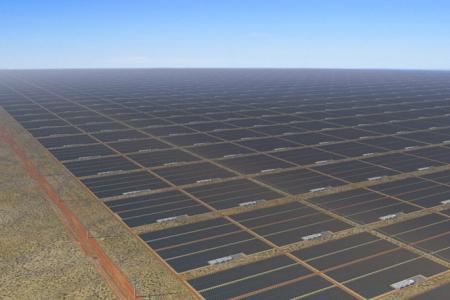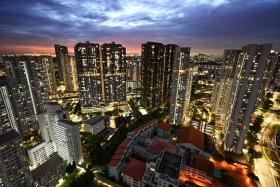S’pore gives conditional nod to import solar power from Australia
Singapore has granted conditional approval to Sun Cable’s US$24 billion (S$31.5 billion) import of 1.75 gigawatt of solar power from Australia’s Northern Territory, which will begin after 2035, Second Minister for Trade and Industry Tan See Leng said on Oct 22.
The project will involve building a massive solar farm in the Northern Territory, passing through Darwin, before the electricity is transmitted via 4,300km of subsea cables from Darwin to Singapore.
Speaking at the Asia Clean Energy Summit on the second day of the Singapore International Energy Week, Dr Tan said the project is an ambitious one, considering the scale and distance between Australia and Singapore.
He added that the Government will continue to greenlight credible clean electricity import projects even if they take longer to materialise, beyond 2035.
This comes as Singapore raised its clean electricity import target to 6GW in September, which will account for around 30 per cent of electricity demand by 2035. Aside from the Sun Cable project, 5.6GW of import deals have been signed with Indonesia, Cambodia and Vietnam thus far.
Dr Tan said on Oct 22 that the Energy Market Authority (EMA) recognises Sun Cable’s project to be “technically and commercially viable” based on the proposal and information submitted thus far.
For the project to advance to further development stages and receive regulatory approval, Sun Cable will need to offer a “commercially viable price acceptable to customers”, said the agency.
In an interview with reporters, Sun Cable chief executive Mitesh Patel said that between now and 2035, the company is seeking to sign long-term purchase agreements with corporate buyers in Singapore, which can range from big tech companies to pharmaceutical firms, for the sale of its clean electricity.
The first phase of the solar project will supply a total of 800 to 900 megawatts of solar power to industrial estates in Darwin, with the remaining 1.75GW exported to Singapore.
This would require its solar plant to have a capacity of between 17 and 20 GW-peak, making it one of the “largest renewable energy installations globally”. Its battery storage system will have a capacity of between 37 and 42 GW-hours to level energy availability, given that sunlight is not available round the clock.
Dr Tan said to advance the project, Sun Cable will need to further validate its technical and commercial plans, and secure all requisite approvals from relevant jurisdictions, including countries through which the cables will pass.
EMA said, in response to queries, that depending on the route that the company eventually chooses, the subsea cables may pass through Singapore, Australia and Indonesia.
Sun Cable had in 2021 received approval from the Indonesian authorities to conduct subsea surveys in their territorial waters, and to map the underwater cable route to Singapore.
Mr Patel told reporters that the company has completed a subsea survey for about 70 per cent of the route thus far.
By 2027, he expects the company to reach financial close – which is when all the project and financing agreements have been signed. By then, the construction activity would have started.
This would comprise three elements: the building of the solar farm, along with a battery storage system, the overhead transmission line from the solar farm to Darwin, and the construction of the subsea cable from Darwin to Singapore.
“As we go forward, we will refine those timelines because we are still at planning and development stage,” Mr Patel added.
The construction is estimated to cost US$24 billion.
Some US$170 million had already been invested in the project over the past three years, making “substantial progress” in achieving milestones for the project development, said Mr Patel.
They include obtaining environmental approval for the project’s development, securing land options for the solar farm, and conducting the subsea cable survey, he added.
Asked to estimate the price that the company is looking to charge for its green electricity, Mr Patel said that electricity prices are influenced by several factors, and it is “too early” for the company to provide a specific price point.
“We have certain advantages with our project, (such as) very good sun resources in Australia, which is one of the top 5 per cent globally, and we are also supplying 24/7 renewable energy, which has the resilience and stability of the grid.
“So with these advantages, we feel confident that our energy prices will be competitively priced,” he added.
The ambitious project began as early as 2019, with a view to begin construction as early as mid-2023. Operations were projected to start in early 2026 and complete by late-2027.
However, in January 2023, the project collapsed when Sun Cable entered voluntary administration due to a funding dispute between Australian mining magnate Andrew Forrest and tech firm Atlassian co-founder Mike Cannon-Brookes.
By May that year, a consortium led by Mr Cannon-Brookes’ Grok Ventures acquired the company, finalising the takeover in September 2023. The Australian government gave the project a go-ahead in August 2024, allowing the electricity to be exported to Singapore.
Asked how the financial sustainability of the project will be ensured, Mr Patel said that Grok Ventures, the majority owner of the company, is fully committed to it.
“Their vision is to unlock the potential of long distance interconnectors in decarbonising the region and the world,” he added.
Get The New Paper on your phone with the free TNP app. Download from the Apple App Store or Google Play Store now


